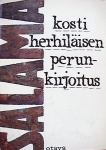"Well-being", it's a modern thing
| I have in a couple of earlier entries (side-dish shop; pizza and well-being) noted the present marketing and life-style fad of "well-being" (웰빙), which is about eating and living healthily and so on. This is just a short piece in Chosun about the phenomenon, that also wheat flour must be manufactured and marketed in the "well-being" mode in order to sell well. Black bean flour is mixed into wheat flour and sold as a health product. Black beans have become known as a foodstuff good in preventing the "adult diseases" (sônginbyông), diseases that one's in danger of contracting when growing older. Still, a comment from Chosun's "100-character comments", suspecting that it's a marketing plot to raise prices: 웰빙.. 좋은 말인데, 맛은 있겠는지.. 괜히 섞느라 가격만 더 올라가는 것은 아닐까? 웰빙이 붙으면 얼마나 가격이 올라가는지 비교해 보자. It's difficult to be critical of this fad, but I wonder when this spreads from housewives to cover also for example the working hours and semi-compulsory drinking and others. But, of course this "well-being" trend is about women taking care of their husbands who meet all the dangers of the world and are at risk of getting a sônginbyông. These deseases tend not to be associated with women. It's a very interesting phenomenon and one of the latest things in what is it to be modern in Korea. And part of it is this reappreciation of traditional things. In the 60s mixing white rice with barley and beans was a sign of poverty, that the person (or the whole nation) didn't have enough rice.  (Those interested in a scholarly treatment [see my pun!] of the concept of sônginbyông can read June J. H. Lee's "Discourses of Illness, Meanings of Modernity: A Gendered Construction of Sônginbyông" in Under Cosntruction: The Gendering of Modernity, Class, and Consumption in the Republic of Korea, ed. by Laurel Kendall, Hawai'i UP 2002) (Those interested in a scholarly treatment [see my pun!] of the concept of sônginbyông can read June J. H. Lee's "Discourses of Illness, Meanings of Modernity: A Gendered Construction of Sônginbyông" in Under Cosntruction: The Gendering of Modernity, Class, and Consumption in the Republic of Korea, ed. by Laurel Kendall, Hawai'i UP 2002)It's no different from what we've had here; consumption of white wheat bread grew when the nation got wealthier, but now the good old rye bread is firmly in its traditional position. The Nordic Rye Group says: Eat rye! Which reminds me that rye bread has been part of the well-being campaigning also in Korea. Here's a rye burger from Lotteria, quite different from the rye bread in the other picture: Update. Hankyoreh has a piece on "well-being" home electronic appliances. The sales of electronic appliances are down, but gadgets to improve health and well-being like air cleaners (공기청정기) and oxygen generators (산소발생기) are selling well. Categories at del.icio.us/hunjang: modernization ∙ Koreansociety ∙ Koreanculture |


Comments to note ""Well-being", it's a modern thing" (Comments to posts older than 14 days are moderated)
Write a Comment